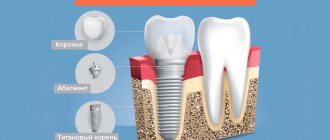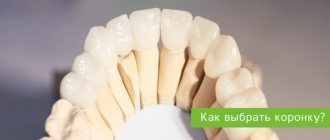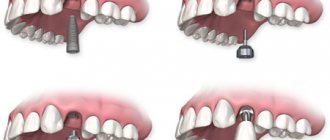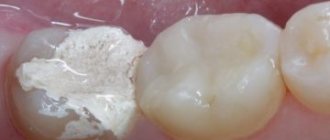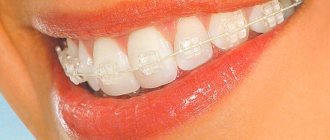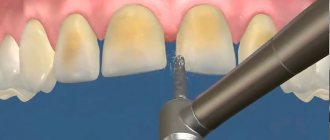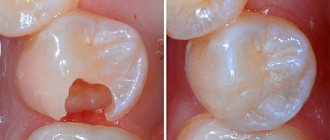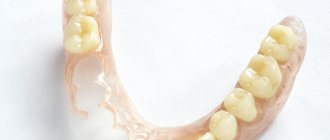Quite often, after an initial dental treatment session with a dentist, the patient returns home with a temporary filling. Many people are beginning to wonder why it is not possible to put in a long-term option to eliminate return visits and whether temporary fillings are simply a way for doctors to make extra money.
Is it possible to remove arsenic or a temporary filling from a tooth on your own at home?
In modern dentistry, arsenic is used quite rarely. However, in some cases, the use of this toxic substance is the only way to cope with toothache. After removing the old filling and placing arsenic paste into the cavity of the diseased tooth, a temporary filling is installed so that the pulp killing agent holds well and does not enter the patient’s body. The dentist extracts the arsenic after a certain time. However, sometimes it becomes necessary to remove it yourself. In this case, you need to follow the rules, otherwise you can only do harm.
Why do they put it on?
If necessary, the dentist may decide to place a temporary filling on the tooth until treatment and finishing are completed.
| Causes | Peculiarities |
| Making a tab | Making an inlay usually takes several days; a temporary filling covers the damaged tooth during this time |
| Nerve removal | Removing a nerve from a tooth is quite painful, so it becomes a way to monitor a diseased tooth. |
| Channel cleaning | Helps to put medicine into the cleaned canal |
| Pulpitis | Together with the temporary filling, a drug is placed that promotes necrotization of the pulp and prevents decay |
| Making decisions about subsequent treatment | Often, a dentist cannot cure a tooth in one session. This may happen due to lack of time or the severity of the case. Serves as a way to preserve canals from contamination between treatment sessions |
| Purulent periodontitis | After removal of pus from the pulp, permanent filling is not recommended, since the risk of re-inflammation is incredibly high. Used as canal cupping |
In what cases may it be necessary to independently remove arsenic or a filling?
Arsenic is used when it is necessary to kill the nerve in order to eliminate painful sensations in the tooth. This toxic substance is used in doses sufficient to affect the nerve endings and tissues of the dental system, but safe for the patient’s health if a number of conditions are met. These include:
- exclusion of contraindications to the use of the drug;
- installing a temporary filling over the poison placed in the cavity of the affected tooth;
- strict adherence to the residence time of arsenic in a dental unit.
This toxic substance is highly toxic. If it is not obtained in time, serious complications may develop. Possible consequences of leaving arsenic in the tooth cavity for too long (more than 7 days) include:
- inflammatory processes in soft dental tissues;
- pulp swelling;
- darkening of the enamel;
- drug-induced periodontitis;
- severe damage to the periosteum and bone;
- development of pathological processes in neighboring teeth.
In addition, if the toxic substance is not removed for too long, intoxication of the body can occur.
Sometimes unforeseen situations arise when, for some reason, it is not possible to remove a temporary filling and remove arsenic in a dental clinic. In such cases, the only way out is to remove the toxic substance yourself, and you will first have to pick out the filling material.
In addition to observing the timing of the arsenic paste in the tooth, you should monitor your well-being. If pain occurs, you must immediately remove the substance. After extraction, in any case, you need to see a doctor for further treatment.
Drugs placed under a sealed barrier
The service life of the temporary plug initially depends on the drug put into it:
- Arsenic is used to kill the nerve in the tooth for subsequent depulpation. For this purpose, a number of other toxic substances are used, which help not only to painlessly remove the nerve, but also to subject the entire pulp tissue to necrosis;
- To treat periodontitis or pulpitis, antiseptics or antibiotics are used to relieve inflammation. Such a filling is usually worn for about 20 days until the infection is completely suppressed.
How to get rid of arsenic?
Before placing arsenic, the old seal is removed and a new one is installed to seal the toxic substance. Since a soft filling material is used in this case, the temporary filling may fall out prematurely. If it is not possible to immediately consult a doctor, the arsenic paste should be removed independently as quickly as possible. Arsenic is removed as follows:
- Teeth are thoroughly cleaned of plaque.
- Hands are washed with soap. Their disinfection with an antiseptic is a mandatory step in preparation for the procedure. For this purpose, you can use any alcohol-containing drink. If you don’t have vodka or alcohol at home, you can use a solution of potassium permanganate.
- Small tweezers or a needle are treated with an antiseptic.
- Using one of the instruments, arsenic is removed from the dental cavity. You need to act as carefully as possible, without violating the integrity of the substance. For convenience, it is recommended to use a mirror. The workplace must be provided with good lighting.
- After the poison is completely eliminated, the oral cavity is rinsed with chamomile decoction, soda solution or an antiseptic.
- A piece of sterile cotton wool or gauze should be placed in the area from which the arsenic was extracted. This measure will avoid contact of food with the dead nerve.
While using arsenic paste, it is not recommended to plan long trips, so that if any painful symptoms occur, you can consult your doctor. Often, teeth that are treated with arsenic are subsequently destroyed, resulting in the need to restore them with a crown.
Necessary actions if a filling falls out
It is important to know what to do if a filling falls out. It is advisable to immediately make an appointment with a dentist, but in some cases it is not possible to urgently visit a doctor. When a filling has come out of a tooth, you can do without it for a short time, but only for a certain time.
If treatment is delayed, the tooth may become infected, leading to acute pain and gradual destruction. It is important to visit a specialist in a timely manner, regardless of whether the filling is permanent or temporary.
But it is better to avoid such a situation and visit the dentist at the stage of loosening. Any gap or even minimal gap between the tooth and the filling is a place for bacteria to enter.
And if you don’t pay attention to such a problem in time, then you shouldn’t be surprised that the filling has fallen out between the teeth.
Most often, such troubles occur with molars. They experience a lot of stress and the filling material can be destroyed if you often eat solid foods. Fillings on the front tooth fall out much less frequently.
How to remove a temporary filling?
Patients often remove temporary fillings at home. Experts note that this is not recommended. However, it is better to remove the filling material and arsenic on your own than to delay the time it remains in the tooth cavity. Removing the seal looks like this:
- After brushing your teeth, you should thoroughly wash your hands and treat them with vodka, alcohol or potassium permanganate dissolved in water.
- The needle, tweezers or toothpick are disinfected.
- Looking in the mirror, you need to carefully pry off the filling with a needle, trying not to injure the gum tissue. The instrument should not be inserted too deeply to avoid pain.
- After removing the filling material, the arsenic paste is removed using the method described above.
- As in the previous case, the oral cavity is thoroughly rinsed with chamomile decoction, soda solution or any other means with a disinfecting effect. After this, the resulting depression in the tooth is closed with a piece of sterile cotton wool.
Read also: How long after you can eat after the dentist
Don’t be afraid that you won’t be able to pick out the temporary filling. The filling material used in this case has a rather fragile structure, due to which it is easily destroyed under mechanical stress. The video below shows how to properly remove a temporary filling and the arsenic underneath.
How long do you need to wear a filling?
You can wear a temporary filling for a period of one day to six months. The maximum validity period of Vinoxol, the strongest and most durable of them, is exactly 6 months. However, such fillings are placed quite rarely, and in general their shelf life depends on their original purpose.
If medicine was placed under the cork, the period will be from 3 to 20 days. In general, the timing of removing the temporary barrier depends entirely on the treating dentist.
Important! You should not wear a temporary filling in your mouth for a longer period than recommended by your doctor, even if it is in perfect order.
When can you not perform the procedure at home?
Strictly speaking, arsenic paste should only be removed in a dental clinic. Carrying out this manipulation without the participation of a doctor can lead to undesirable consequences. The most likely problems that may arise during the arsenic extraction process include:
- injury to the gums with a needle or tweezers;
- infection in damaged soft tissues;
- violation of the integrity of the extracted piece of paste, as a result of which particles of a toxic substance, together with saliva, enter the gastrointestinal tract and cause various damage to internal organs.
To avoid having to remove arsenic at home, certain rules should be followed. To avoid destruction of the temporary filling, food should be chewed on the healthy side. It is not recommended to plan long trips while arsenic paste is in the tooth. Experts urge patients to treat their recommendations with maximum responsibility; only strict adherence to them will help prevent dangerous consequences.
The filling fell out and the tooth chipped
The main hardness of the dental coating is given by mineral substances, which include: eight-calcium phosphate, hydroxyapatite, chloride and carbonate apatites.
Among the reasons why teeth may lose their natural strength are:
- unbalanced and unhealthy diet;
- age-related and other changes affecting the integrity of calcium tissues;
- disruption of intestinal function, as a result of which the absorption of minerals changes significantly;
- deviations caused by hormonal imbalances;
- Increased acidity of the oral cavity also affects the strength of the enamel.
Excessive load that occurs under the following circumstances can lead to tooth chipping:
- injuries resulting from falls;
- malocclusion;
- cracking nuts, or opening bottles with teeth;
- close contact of the teeth with fruit seeds, fish bones, chicken bones, and other hard food particles.
Provoking factors:
- weakening of the strength of teeth can also occur after removal of the nerve, since in this case the tooth becomes almost dead;
- Regular consumption of sweet, sour foods, or carbonated drinks
- insufficient oral care, as a result of which harmful bacteria accumulate in the oral cavity;
- temperature changes when eating hot food after cold food, and vice versa;
For your peace of mind, it is recommended to contact a good dental clinic.
How to get arsenic out of a tooth yourself
Before dentistry reached a high level of development, arsenic was very often used to remove dental nerves. Nowadays this practice is used very rarely, but has not been completely eliminated. There are cases when the patient, for certain reasons, cannot visit the dentist, but the period of action of arsenic is already quite long and it needs to be removed. In such cases, it is necessary to remove the substance from the tooth cavity yourself, as it is very harmful. You need to know how to remove a filling.
Arsenic in a tooth is usually a blue lump of paste
Why is arsenic used in dentistry?
In order to kill the nerve, the dentist can use arsenic in his work. This medication has a necrotic effect on the nerve, which leads to its death. It also has a toxic effect, which requires its short-term use.
In medical practice, the remedy is used to eliminate toothache, which is caused by an open nerve. This can occur as a result of caries, periodontitis, pulpitis and other dental problems.
Arsenic occupies number 33 in the Periodic Table and has another name - arsenum. It is a brittle non-metal substance with toxicity. It has an immunotoxic effect on the human body. A dangerous dosage is 5–50 mg, depending on the individual susceptibility of the body.
The element arsenic is a strong poison
Arsenic in the tooth should not last long.
When performing dental work, the substance falls into the tooth cavity, providing a necrotic effect on the nerve endings and pulp. As a result of this impact, the following processes occur:
- direct cytotoxic effect on cells;
- disruption of cellular respiration and their death;
- denaturation of protein pulp;
- cessation of blood supply to the pulp;
- blocking impulses from nerve endings.
As a result of such processes, the nerve completely dies and becomes insensitive.
The substance is used in the form of a paste, the main component of which is arsenic. As a rule, this is an anhydride: Septodont, Kaustinerv, Pulparsen, Caustitsin, etc.
Arsenic paste for dentistry
The composition of such drugs includes arsenic anhydride, which provides a necrotic effect, as well as a substance that has an anesthetic effect, which allows you to quickly cope with painful sensations. The latter include: novocaine, dicaine, lidocaine.
The components of the paste include substances that ensure the disinfection of dead pulp and the destruction of pathogenic microflora. This may be thymol, carbolic acid and others. Thanks to the astringent components, the diffusion of the main substance is slowed down, as well as the effect of the paste is prolonged.
Regardless of what type of paste is used, it should not remain in the tooth for a long time. Sometimes there are times when you need to get pasta at home. If a person removes a filling, you should try to immediately contact a dentist.
Other useful sections
On these pages you will find information on how to solve the problem of a filling falling out:
- Treatment of caries
- Treatment of periodontitis
- Dental restoration
References for the article:
- “Types of dental fillings” // Information portal Colgate.ru
- Borovsky E.V. “Dental caries. Preparation and filling" - M.: JSC "Dentistry", 2001.
Author of the article: Victoria Igorevna Nikitina
Staff copywriter of the portal Stom-Firms.ru Author specializing in medical texts
How long should arsenic remain in a tooth?
Installing arsenic takes a little time. The dentist performs the following actions:
- pulp opening;
- removal of damaged dentin;
- laying the paste;
- providing sealing using artificial dentin.
Previously, the substance was placed with a closed pulp, but now this practice is not used, as there is a possibility of pain and swelling. Arsenic, depending on which tooth is being treated, is set for the following period of time:
- single-rooted – 24 hours;
- the rest – 48 hours.
It is very important to visit a doctor on the day of your appointment, as prolonged exposure to the substance becomes dangerous.
Read also: Changing baby teeth in children
A temporary filling over arsenic has fallen out - you need to see a doctor urgently
Arsenic should not be kept for more than 62 hours.
There are substances that can be kept for up to two weeks, these include depulpin. It is necessary to clarify with a specialist which particular drug was used. If it is not possible to visit the dentist at the appointed time, you need to extract the substance yourself. You need to be very careful with arsenic so that it does not enter the gastrointestinal tract when extracted. You need to remove it yourself for certain reasons.
Why might you need to extract arsenic yourself?
Arsenic paste has a high toxicity rate. It needs to be taken out in time. If it remains in the tooth for more than a week, inflammation of the soft dental tissues and other negative processes develop, which include:
- swelling of the pulp;
- darkening of dentin;
- drug-induced periodontitis;
- death of the periosteum and bone;
- necrotic effect on adjacent teeth.
It is necessary to keep the substance for the prescribed time and not violate the terms of its withdrawal. Just in case, you need to know how to remove arsenic from a tooth yourself. With prolonged exposure to the paste, complete intoxication of the body can occur. And also negative phenomena can occur with an incorrectly calculated dose.
Due to such a high risk of adverse reactions, the drug is used very rarely, although it used to be quite common.
The patient should be attentive to the timing of use of arsenic paste and do not forget to visit a doctor. You need to know when to get the pasta. Despite its necrotic and analgesic effect, the substance located in the tooth can cause pain, which also requires its immediate removal.
A tooth with arsenic hurts - it needs to be removed
The causes of pain are the following:
- the substance does not kill nerve endings, since it is not concentrated enough;
- long duration of action of certain drugs;
- inflammation of tooth tissue;
- necrosis in the area of the periosteum or jawbone;
- substance intolerance;
- incorrectly inserted paste.
Any of these reasons causes pain, which should alert the patient and remove the substance. You need to immediately consult a doctor or, at first, get the paste yourself. When a person removes a substance himself, he must understand that subsequent treatment cannot be avoided.
Treatment process
People faced with such a problem are interested in how the tooth will be treated when the filling has fallen out. It all depends on individual characteristics, so it is worth considering the most common situations.
If the carious cavity is too large, it makes no sense to fill it again. The material will not hold and will fall out again after a short time. Therefore, the doctor will suggest alternative methods of eliminating the defect, most likely installing a crown.
If repeated caries occurs, pulpitis or other diseases develop, they must first be cured. The doctor prescribes and carries out all the necessary measures and, after complete recovery, places a new filling. If the filling material falls out of a pulpless tooth, re-filling is often also ineffective. In this case, the specialist will recommend installing a pin.
Methods for restoring the integrity of a tooth depend on its condition, so it is difficult to suggest a treatment plan without a preliminary examination.
How to extract the substance yourself?
After the doctor places the arsenic paste, a filling is placed on top, which prevents it from falling out of the tooth cavity. Sometimes it falls out on its own, which requires immediate attention to the dentist.
Removing arsenic paste yourself is dangerous. In addition, if you open the filling, the pain may only intensify. If the pain has stopped and the prescribed period of wearing the substance has expired, you can still try to remove it, if it is not possible to visit a specialist. There are certain steps that need to be taken.
- Brush your teeth well.
- Wash your hands with soap and treat with an antiseptic.
- Prepare a tool: a syringe or sewing needle, thin tweezers, and a toothpick will do. The item must be treated with an antiseptic. You can use alcohol, vodka, and potassium permanganate solution.
- Stand in front of the mirror and lightly pick up the filling without touching the gums. Do not insert the needle too deeply, as this may cause pain.
- After removing the filling, you need to try to get the substance out so that it does not crumble in the oral cavity.
- After completely cleaning the tooth from the drug, you need to rinse your mouth with an antiseptic or chamomile infusion.
A visit to the dentist for dental cleaning and treatment is mandatory.
Many people ask: if I remove the substance itself, what will happen. Nothing fatal will happen, but further treatment cannot be avoided. After arsenic has been removed, you should consult a doctor as soon as possible, since during the period of its action, the walls of the tooth have become thin, like its other parts, which can lead to its rapid destruction.
It is recommended not to plan long trips if arsenic has been detected, so that at the first appearance of negative symptoms you can consult a specialist. And it is also better to choose a method of treating dental nerves that does not use such a substance.
Very often, teeth that are treated with arsenic paste quickly crumble, which requires the installation of a crown.
Removing arsenic is very simple, but the consequences after it are very costly and long-lasting. You need to constantly visit the dentist to avoid moments when the tooth can no longer be saved except with the help of arsenic paste. It is recommended to use a good toothpaste that protects against caries.
How do dentists treat the disease?
It is advisable to begin treatment of pulpitis in a timely manner, as this can lead to negative consequences and certain complications, for example, periodontitis. Dentists immediately try to relieve the patient of pain, inflammation, eliminate the infection and gradually restore the functionality of the pulp, if possible.
As soon as a patient with acute pulpitis sees a specialist, an anesthetic is injected into the carious cavity, and an analgesic is taken orally. After a thorough examination of the oral cavity, a treatment method is selected - conservative or surgical.
Conservative treatment - helps to get rid of pain, inflammation with the help of medications and physiological methods of therapy that are aimed at preserving the pulp. In such a situation, a biological method is used. Sometimes the patient undergoes partial removal of the pulp, but its viability remains.
Conservative treatment is considered a one-session treatment in most cases, but it may take several days to resolve the problem. There are such indications for the biological method of therapy as focal pulpitis in the acute stage, exposure of the pulp when the dental crown is broken, chronic fibrous pulpitis, the patient’s age is not more than 29 years, no changes in the area of the apical foramen, there is no possibility of prosthetics, and others.
Conservative therapy includes the following steps:
- Anesthesia.
- Treatment of carious cavity with instruments and medications.
- Degreasing procedures, drying the cavity.
- Applying an insulating gasket to the bottom of the pulp and installing a filling.
It is possible and advisable to treat pulpitis surgically only if conservative treatment is impossible. It involves removing the pulp completely, then filling the canals and, accordingly, the dental crown. This method of therapy is considered the most reliable and is carried out in several visits to a specialist:
- Use of anesthesia.
- Removal of carious tissue from the cavity.
- Protecting the tooth from moisture using a rubber dam.
- Removing pulp from the crown and canals.
- Measuring the length of canals, their processing, expansion and filling.
- Rinsing the canals with antiseptics, applying an antiseptic, then placing a temporary filling.
- Removal of temporary filling and preparation from the canals.
- Rinsing the canals and drying them.
- Filling canals with gutta-percha.
- X-ray examination, which helps to track the correctness of the canal filling.
- Installation of a permanent filling.
Why is arsenic needed in dental treatment?
The limit varies from 5 to 50 mg depending on the weight parameters and sensitivity of the patient. Nowadays they use not arsenic, but a paste based on it containing:
- 1/3 of the paste is arsenic anhydride;
- less than 1/3 of the composition is a substance for accelerated pain relief;
- 5% camphor or thymol to eliminate microflora and sterility of the pulp;
- only 1% tannin - to extend the effect of the drug to 2 days, since this substance can slow down the process of diffusion of arsenic into the pulp tissue.
Read also: Distal occlusion is
Indications and contraindications for use
The drug is used when it is necessary to remove a nerve and to prevent further pain during therapy.
A small dose of arsenic in the tooth and the required exposure for a certain time cannot harm the patient. Before starting any treatment procedure, the dentist must make sure that the patient has no contraindications for a specific therapy. There are not many of them, but a competent doctor should take into account all the points when using arsenic paste in each individual case. The drug is not applicable if:
- diseases associated with the genitourinary system;
- individual intolerance to any component of the paste containing arsenic;
- child under two years of age, during pregnancy or breastfeeding;
- restrictions on accessibility to the dental canal, and when it is impossible to apply arsenic topically.
What to do if a tooth hurts after filling?
There is no need to endure pain symptoms under a filled tooth. At home, you can temporarily use regular pharmaceutical products. However, if this does not help, especially at night, you should immediately go to the doctor and take out the paste. Sometimes the pain increases to an unbearable degree. This is possible in the following cases:
- insufficient dosage or the presence of a high threshold of sensitivity to the drug in a person;
- the duration of the period of exposure of the substance to the nerve, when the pain subsides only by the third day;
- the drug inflames the soft tissue, which is accompanied by swelling, and the temperature may rise; you should urgently consult a doctor and get the paste;
- the occurrence of inflammation in any part of the tooth is a serious problem that requires long-term and expensive treatment;
- if you are intolerant to one of the components of the paste or arsenic, when allergic swelling or other dangerous reactions occur, for example, a shock effect, if symptoms increase, immediately call an ambulance;
- incorrect installation of the drug.
